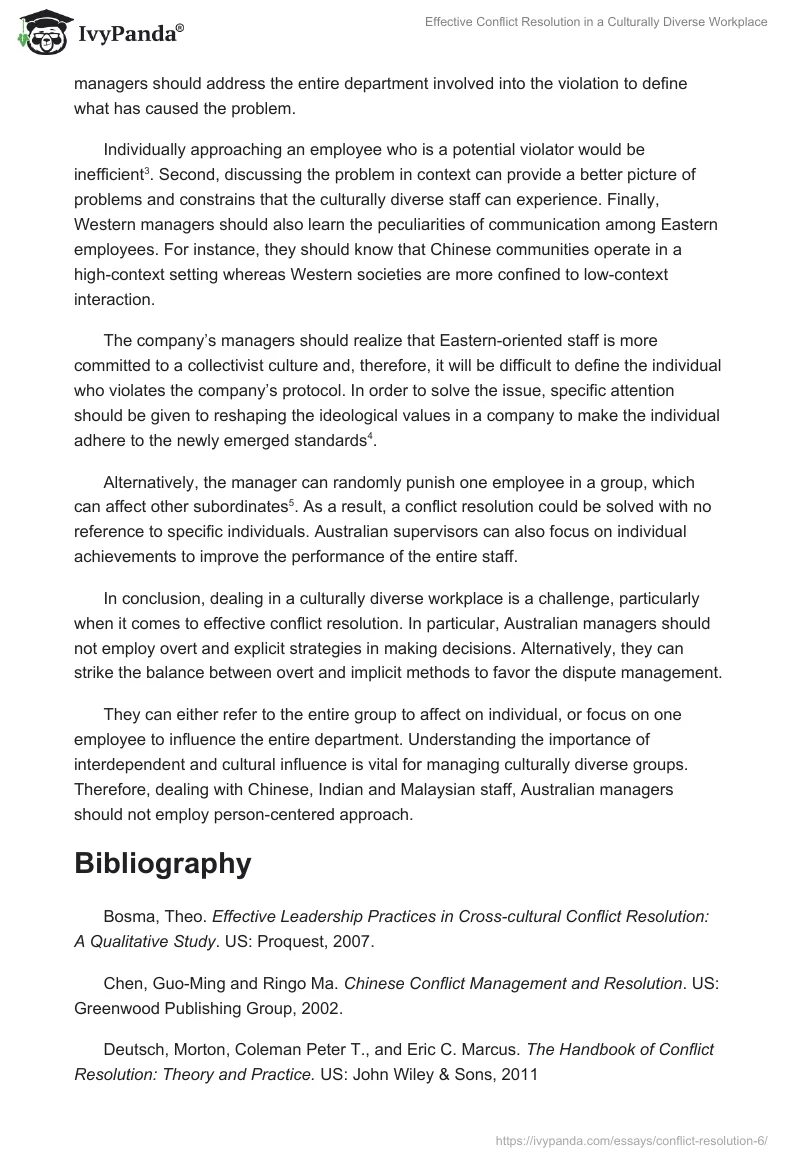Understanding the influence of sociocultural environment on conflict resolution in a business setting is indispensible to successful cooperation and communication. It is widely recognized that Western managers prefer solving problems overtly and address the issues explicitly.
Such an approach to conflict resolution explains the self-construct in Western societies and characterizes individuals as those who are more focused on self-expression and determination. In contrast, Eastern managers are more interested in avoiding the conflict, or solving it implicitly.
However, when Western business executives confront issues in a culturally diverse environment, they often face challenges in solving conflict because of discrepancies in understanding nature of misconceptions and establishing contacts with individuals from different cultural backgrounds.
While operating in an Australian business setting, managers pay close attention to strict observance of regulatory status and codes of conduct. Therefore, such principles as justice, equality, and fair treatment are among the priorities that are considered by Australian CEOs.
Despite this objective attitude, business companies in Australia are more reminiscent of the Western style of controlling the managerial process and, therefore, resolving conflicts with Eastern communities can pose a serious problem on their relations. In particular, Australian managers dealing with Chinese, Malaysian, and Indian staff should be more focused on social commitment and development of high-context communication.
In order to enrich organizational culture and improve the overall employed environment in an organization, Australian managers should make a shift to a collectivist thinking to understand the in-group activities performed by Eastern members of an organization. Hence, while dealing with breach of the company’s protocol, the managers should address the entire department involved into the violation to define what has caused the problem.
Individually approaching an employee who is a potential violator would be inefficient. Second, discussing the problem in context can provide a better picture of problems and constrains that the culturally diverse staff can experience. Finally, Western managers should also learn the peculiarities of communication among Eastern employees. For instance, they should know that Chinese communities operate in a high-context setting whereas Western societies are more confined to low-context interaction.
The company’s managers should realize that Eastern-oriented staff is more committed to a collectivist culture and, therefore, it will be difficult to define the individual who violates the company’s protocol. In order to solve the issue, specific attention should be given to reshaping the ideological values in a company to make the individual adhere to the newly emerged standards.
Alternatively, the manager can randomly punish one employee in a group, which can affect other subordinates. As a result, a conflict resolution could be solved with no reference to specific individuals. Australian supervisors can also focus on individual achievements to improve the performance of the entire staff.
In conclusion, dealing in a culturally diverse workplace is a challenge, particularly when it comes to effective conflict resolution. In particular, Australian managers should not employ overt and explicit strategies in making decisions. Alternatively, they can strike the balance between overt and implicit methods to favor the dispute management.
They can either refer to the entire group to affect on individual, or focus on one employee to influence the entire department. Understanding the importance of interdependent and cultural influence is vital for managing culturally diverse groups. Therefore, dealing with Chinese, Indian and Malaysian staff, Australian managers should not employ person-centered approach.
Bibliography
Bosma, Theo. Effective Leadership Practices in Cross-cultural Conflict Resolution: A Qualitative Study. US: Proquest, 2007.
Chen, Guo-Ming and Ringo Ma. Chinese Conflict Management and Resolution. US: Greenwood Publishing Group, 2002.
Deutsch, Morton, Coleman Peter T., and Eric C. Marcus. The Handbook of Conflict Resolution: Theory and Practice. US: John Wiley & Sons, 2011
Henderson, George. Cultural Diversity in the Workplace: Issues and Strategies. Quorum Books, 1994.
Van Gramberg, Bernadine. Managing Workplace Conflict: Alternative Dispute Resolution in Australia. US: Federation Press. 2006.


